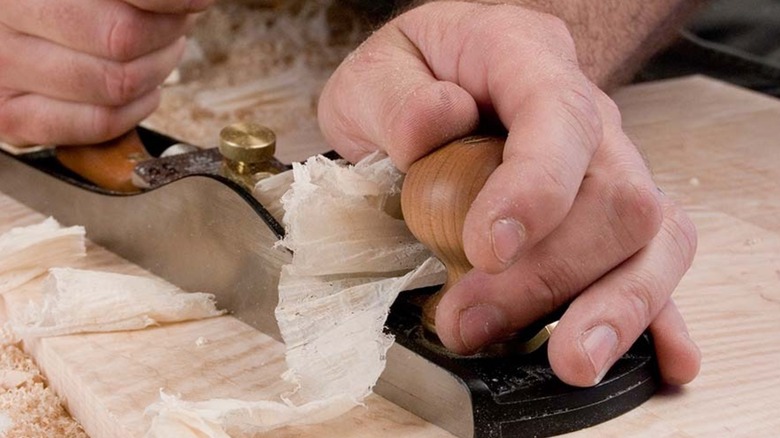Bench Planes Vs. Block Planes: What's The Difference Between These Woodworking Tools?
Hand planes often fall into the category of essential woodworking tools under $100. They come in a variety of designs, shapes, and sizes, with the popular versions divided loosely into bench planes and block planes. While one of the most common differences between the two types is the orientation of the cutting blade bevel, other distinctions include the design, size of the tool, and the type of handle present.
Bench planes have cutting blades installed so the bevel is facing down, a cutting angle of 45 degrees, and a chip breaker on top of the blade to direct shavings. These types of planes are typically among the largest versions of the hand planes woodworkers will encounter, measuring from around nine inches up to nearly two feet in length. They'll have a comfortable handle at the back end and a knob at the front for two-handed operation and maximum control when smoothing long surfaces, most usually with the grain.
Conversely, block planes have the blade bevel installed facing up and feature a choice of cutting angles. A standard-angle block plane has its blade set to 20 degrees, while a low-angle block plane is set at 12 degrees. Some woodworkers, such as Rex Krueger, point out that the blade's sharpening bevel, often 25 degrees, should be included in the cutting-angle calculation. This would make the standard-angle block plane cut-angle 45 degrees (the same as the bench plane) and the low-angle version 37 degrees. At six to seven inches, block planes are portable and convenient for smaller jobs, often used for end-grain work.
Which type of hand plane is best for woodworkers?
While many woodworkers advocate the virtues of having a variety of hand planes, including bench and block types, in their tool boxes, budget restraints often require making tough choices. Keep in mind that there is a difference between woodworking and carpentry, and the best tools for one don't always work best for the other.
Block planes, being smaller, simpler tools, are generally less expensive than bench planes of comparable quality. For example, Lie-Nielsen ToolWorks' smallest bench plane, a No. 1 measuring 5.5 inches in length, has a list price of $285, while its 5.25-inch No. 103 block plane is $160. The upper end of the price range includes a No. 8 Jointer Bench Plane that's 24 inches long, weighs 10 pounds, and costs $550.
For woodworkers who can only justify one hand plane for use on a variety of projects, a low-angle bench plane patterned after the Stanley No. 62, such as the $295 Lie-Nielsen No. 62, could be the best option. The Lie-Nielsen No. 62 measures 14 inches in length and weighs 4.55 pounds. Its unique design places the blade at 12 degrees with the bevel up.
Sharpening multiple blades at different bevel angles allows performing different tasks. If the project requires cutting end grain, sharpen a blade to 25 or 30 degrees, depending on the hardness of the wood and the grain structure. Smoothing a door or drawer edge? Use a 35-degree blade. When cutting wavy grain, a 40-degree (or higher) blade could be best to avoid tear-out.

